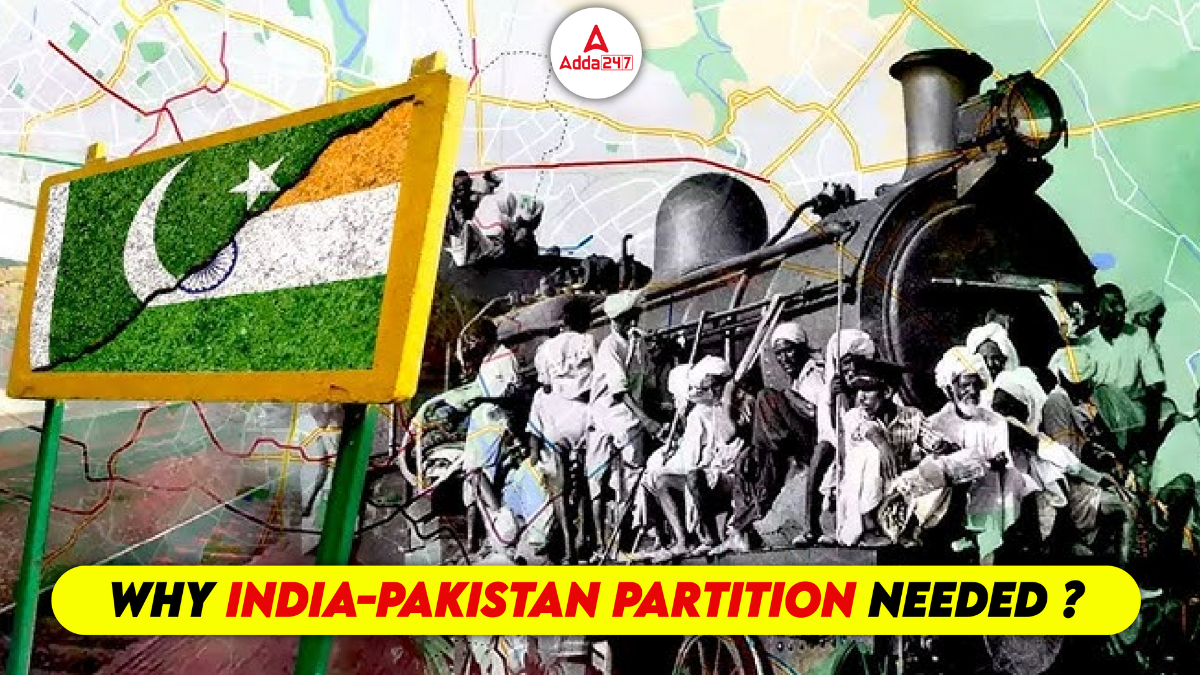In August 1947 British India was partitioned, ending three hundred years of colonial rule with the creation two independent nations: India and Pakistan (comprising West and East Pakistan, present-day Bangladesh). From the tumultuous and tragic set of events that encompass this ‘Great’ and ‘Long’ Partition, much is set in stone: partition caused the ‘greatest mass movement of humanity in history’.
India- Pakistan Partition
The partition of India and Pakistan in 1947 was a complex and highly contentious event driven by a combination of political, social, and religious factors.
There are some main reasons that contributed to the necessity of partition:
Religious Differences and Communal Tensions
- Diverse Religious Composition: India was home to a large Hindu majority and a significant Muslim minority, along with other religious groups like Sikhs, Christians, and Buddhists. Over time, religious tensions grew between Hindus and Muslims.
- Communal Riots: The years leading up to partition saw increasing communal violence, with significant riots in places like Bengal, Bihar, and Punjab. These tensions made coexistence increasingly difficult and fueled demands for separate nations.
Demand for a Separate Muslim State
- Two-Nation Theory: The All-India Muslim League, led by Muhammad Ali Jinnah, propagated the idea that Muslims in India were not merely a religious community but a separate nation with their own identity and rights. The demand for a separate Muslim state became stronger, especially after the Lahore Resolution in 1940, which called for “independent states” for Muslims in the north-western and eastern zones of India.
- Fear of Hindu Dominance: Muslims, especially in regions where they were a minority, feared that after independence, they would be politically marginalized in a Hindu-majority India. This fear was instrumental in the push for a separate Muslim state, Pakistan.
Failure of Political Negotiations
- Cripps Mission and Cabinet Mission: The British government made several attempts to negotiate a settlement between the Indian National Congress, which largely represented Hindu interests, and the Muslim League. However, these efforts failed, primarily because of disagreements over the level of autonomy that Muslim-majority regions should have.
- Direct Action Day: In August 1946, the Muslim League called for Direct Action Day to assert their demand for Pakistan. This led to widespread communal violence, particularly in Bengal, and further entrenched the idea that Hindus and Muslims could not coexist in a single nation.
British Colonial Policies
- Divide and Rule: The British colonial strategy often played on religious divisions to maintain control over India. This policy contributed to deepening the rift between Hindus and Muslims over the decades.
- Mountbatten Plan: As the independence movement gained momentum and World War II weakened Britain’s control, the British decided to grant India independence. However, they also recognized the growing demand for a separate Muslim state and ultimately agreed to the partition, as proposed in the Mountbatten Plan of June 1947.
Political Leadership and Ideological Differences
- Indian National Congress vs. Muslim League: The Indian National Congress, led by leaders like Mahatma Gandhi and Jawaharlal Nehru, sought a united India with a secular government. In contrast, the Muslim League, under Jinnah, argued that Muslims needed their own state to protect their rights and interests.
- Mistrust and Intransigence: The deep mistrust between the Congress and the Muslim League, coupled with their inability to agree on a power-sharing formula, made partition seem like the only viable solution to the political deadlock.
British Haste in Exiting India
- Rapid Transfer of Power: The British government, eager to leave India after World War II, accelerated the process of independence. The hastily drawn boundaries by the Boundary Commission, led by Sir Cyril Radcliffe, exacerbated the problems of partition by dividing communities, villages, and even families.
Violence and Mass Displacement
- Mass Migration: The partition led to one of the largest mass migrations in human history, with millions of Hindus, Muslims, and Sikhs fleeing their homes to cross the newly drawn borders. This migration was accompanied by horrific violence, with an estimated 1-2 million people killed.
A solution to the immediate problem of communal tensions
The partition of India and Pakistan was driven by a combination of religious, political, and colonial factors. It was seen as a necessary step to address the conflicting demands of the Hindu and Muslim communities, but it also led to one of the most tragic and violent events in modern history. While partition provided a solution to the immediate problem of communal tensions, it left a legacy of bitterness and conflict that continues to affect India-Pakistan relations to this day.




 Today The Hindu Editorial of 1 August 20...
Today The Hindu Editorial of 1 August 20...
 The Hindu Editorial Today 31 July 2024, ...
The Hindu Editorial Today 31 July 2024, ...
 The Hindu Editorial of 30 July 2024 For ...
The Hindu Editorial of 30 July 2024 For ...







